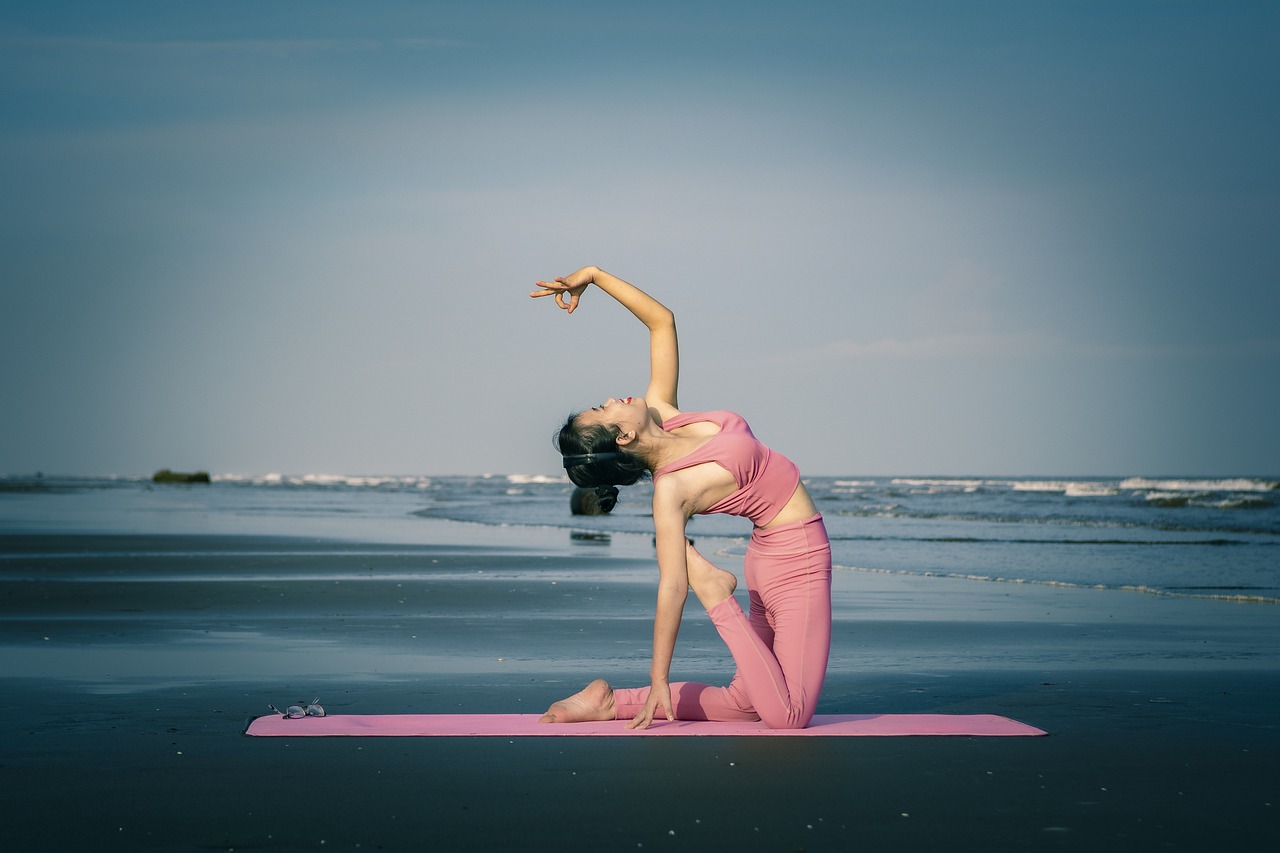Creating a Personal Yoga Space at Home

Before diving in, please note: This post is for informational purposes only. If you’d like to know more about how we approach topics, feel free to check out our friendly Disclaimer Page.
Hey there, amazing readers! 🖐️ Just a quick note: yes, we know there are a lot of ads here. Trust us, we get it—it’s not the prettiest look, but they help us keep this blog alive and kicking. Those pesky little ads cover the costs of all the behind-the-scenes magic, from hosting and tech stuff to creating content we hope you’ll love.
We’re committed to delivering quality posts, and your support (even just sticking around despite the ads) means everything to us. So, bear with us, and thanks for helping us keep the good vibes rolling. Now, on to the fun stuff! 😉
TRANSLATE BUTTON AT THE END OF THE ARTICLE
A Quick Overview
Creating a personal yoga space at home isn’t just about unrolling a mat; it’s about crafting an environment that nurtures your practice and supports your well-being.
In our busy lives, carving out a sanctuary for self-care can feel challenging, but it’s incredibly rewarding.
Whether you are a seasoned yogi or just starting on your journey, having a dedicated space can enhance your experience and invite tranquility into your day.
In this article, I’ll guide you through the process of creating a cozy and inspiring yoga nook that reflects your style and meets your needs.
Why a Personal Yoga Space is Important for You
Establishing a personal yoga space at home serves several beneficial purposes.
First and foremost, it offers a sense of routine and ritual.
When you know there’s a dedicated spot waiting for you, it becomes easier to commit to your practice.
It signals to your mind that it’s time to let go of the day’s stress and focus on your body and breath.
Moreover, this space can act as a retreat from the hustle and bustle of daily life.
Imagine walking into a room that feels like a haven.
It’s an opportunity to disconnect from the outside world and reconnect with yourself.
In moments of chaos, having a place where you can ground yourself becomes invaluable.
Your personal space also fosters creativity and personal expression.
You can design it according to what resonates with you, using colors, decorations, and scents that inspire peace and joy.
It encourages you to experiment and explore different styles of yoga, whether it’s restorative, vinyasa, or aerial.
Additionally, a dedicated yoga area can impact your physical health.
The mere act of stepping into your space can help signal your body that it’s time to stretch, strengthen, and move.
You may notice improvements in your flexibility, balance, and overall well-being as a result of consistent practice.
Lastly, having a personal yoga space can encourage mindfulness.
When you step into your designated area, you’re prompted to be present.
It can remind you to breathe, to focus, and to enjoy the moment—something that can be all too easy to forget in our fast-paced lives.
Choosing the Perfect Spot in Your Home
When selecting a location for your yoga space, think about what works best for you.
Ideally, look for a spot that feels serene and has enough room to stretch out fully.
Here are some tips to help you find that perfect place:
Natural Light: A space with natural light can uplift your mood.
Try to find a room or corner that welcomes sunlight, which can help you feel more energized and alive during your practice.
Quiet Environment: Choose a spot away from noise and distractions.
This might mean steering clear of busy living areas or locating yourself in a quiet corner of a bedroom.
Space to Move: Ensure your chosen area has enough room to perform your poses comfortably.
You’ll want to roll out your mat and move freely without bumping into furniture or walls.
Airflow: Good ventilation can make a huge difference.
Open windows can create a natural flow of air, making your practice more refreshing and pleasant.
Accessibility: Your yoga space should be easy to access.
If it’s too far away or inconvenient, you might find it harder to stick to your routine.
After considering these factors, claim your space!
Whether it’s a spare room, a corner of your living room, or even your patio, make it your own.
Clearing the Clutter: A Fresh Start for Yoga
Clutter can be a significant barrier to peace and focus.
The first step in creating your yoga sanctuary is to clear out the chaos.
Here’s how you can do that:
Declutter the Area: Remove items that don’t belong in your yoga space.
Keep only what inspires you.
If it doesn’t serve your practice, consider relocating it.
Organize: Find a home for your yoga props, whether it’s a basket for blocks and straps or a shelf for your mat.
Having everything organized makes it easier to transition into your practice.
Deep Clean: A clean space helps create a calm atmosphere.
Dust shelves, mop the floor, or vacuum the area where you’ll practice.
You’ll feel a sense of accomplishment and readiness.
Simplify: Less is more.
Focus on keeping the space simple and serene.
The fewer distractions, the easier it is to immerse yourself in your practice.
Create Boundaries: If you share your space with others, communicate your needs.
Let them know when you’re practicing and ask for quiet during those times.
Once you’ve cleared the clutter, you’ll feel lighter and more prepared to dive into your yoga journey.
Setting the Right Mood: Lighting and Ambiance
Lighting plays a pivotal role in setting the mood for your practice.
The right ambiance can help you feel more relaxed and focused.
Here are a few ideas:
Natural Light: Whenever possible, utilize natural light.
Should you practice in the morning, the soft glow of sunrise can be invigorating.
Soft Lighting: For evening practices, consider using soft lamps or string lights.
Avoid harsh overhead lighting; instead, opt for warm-toned bulbs that create a cozy feel.
Candles: Lighting candles can enhance the ambiance significantly.
The flickering flame provides a calming presence, and aromatherapy candles can also fill the air with soothing scents.
Dimmer Switches: If your space allows, installing a dimmer switch lets you adjust the lighting according to your mood.
Scented Oils or Incense: Enhance your environment with essential oils or incense.
Scents like lavender or sandalwood can create a peaceful atmosphere.
With the right lighting, you’ll transform your yoga space into an inviting sanctuary that welcomes you, day or night.
Essential Yoga Props for Your Home Sanctuary
Having the right props can elevate your yoga experience.
While you might think you need a gym full of equipment, it’s quite the opposite.
Here are some essentials:
Yoga Mat: This is your foundation.
Choose a mat that provides comfort and grip.
Look for one that suits your practice style—some prefer thicker mats for support, while others like thinner ones for stability.
Yoga Blocks: These handy tools help modify poses and provide support.
They can be a game-changer, especially if you’re working on your flexibility.
Straps: If you struggle with certain poses, a strap can help you reach further without straining.
It’s an excellent tool for deepening stretches.
Bolster or Cushion: These can support restorative poses, making your practice more comfortable.
Blanket: A soft blanket adds warmth and comfort.
It can also provide cushioning for knees and wrists.
Meditation Cushion: If you meditate, a cushion can make your seated position more pleasant, encouraging longer meditative sessions.
Investing in these essentials doesn’t have to break the bank.
You can often find affordable options at local stores or even craft your own props.
Personalizing Your Space with Colors and Decor
Your yoga space is an extension of yourself, so make it personal!
The colors and décor you choose can significantly impact your mood.
Here are ways to express your unique style:
Color Theory: Consider using calming colors like blues and greens that promote tranquility.
Warm colors can inspire energy and creativity.
Think about what feelings you wish to evoke.
Artwork: Hang art that resonates with you.
It could be a calming landscape, a motivational quote, or something that inspires your practice.
Images of Nature: Pictures of nature can enhance the peaceful vibe of your space.
Incorporate elements that remind you of the outdoors.
Inspirational Quotes: Hang quotes that motivate you.
This can be a gentle reminder of your intentions each time you practice.
Personal Mementos: Include items that have personal meaning.
It could be a souvenir from a retreat, a gift from a friend, or anything that fills you with positive energy.
Personalizing your space makes it feel special and inviting, encouraging you to spend more time there.
Incorporating Nature: Plants and Fresh Air
Nature has a unique ability to soothe and rejuvenate.
Incorporating plants into your yoga sanctuary can breathe life into your space.
Here’s how to do it:
Choose Low-Maintenance Plants: If you’re new to gardening, opt for low-maintenance varieties like snake plants or pothos.
They thrive in various conditions and purify the air.
Fresh Air: Open windows can enhance airflow, bringing fresh oxygen into the space.
It can also invigorate your practice.
Herbs: If you have a sunny kitchen window, consider growing herbs like basil or mint.
They not only purify the air but can also be used in teas.
Nature Sounds: If you can’t bring the outdoors in, consider playing nature sounds—like flowing water or chirping birds—during your practice.
Natural Materials: Incorporate natural materials in your decor, like wooden shelves or bamboo mats.
They create a seamless connection to the earth.
With these elements, you’ll transform your yoga space into a natural retreat that nurtures your body and mind.
Creating a Comfortable Floor Setup for Practice
The floor setup can significantly affect your yoga experience.
A comfortable setup encourages longer and more productive sessions.
Here are some ideas:
Use a Soft Surface: If you have hard floors, consider using a rug or carpet to soften the surface.
It can make a world of difference, especially during floor poses.
Layer Your Yoga Mat: If you prefer a little extra cushioning, consider layering your yoga mat with a blanket or towel.
Arrange Your Props: Keep your props within reach.
Set them up in a way that allows you to transition easily between poses without disrupting your flow.
Comfortable Clothing: Ensure you wear clothing that allows for movement.
Invest in breathable fabrics that won’t restrict your practice.
Create Zones: If you have space, designate areas for different activities (like meditation or restorative yoga).
It can help mentally separate varied practices.
A comfortable floor setup makes practicing more enjoyable, allowing you to focus on your movements and mind without distraction.
Music and Sound: Curating Your Yoga Playlist
Music can transform your yoga experience.
The right tunes set the tone and can help guide your practice.
Here’s how to create the perfect playlist:
Choose Soothing Sounds: Look for soft instrumental music or nature sounds.
Genres like ambient, classical, or acoustic often work beautifully.
Match the Tempo: Consider the style of yoga you’re practicing.
Slow-paced music suits restorative sessions, while upbeat tracks may energize vinyasa flows.
Limit Lyrics: Instrumentals tend to be less distracting.
If you enjoy songs with lyrics, choose ones that inspire rather than distract.
Create Variety: Mix different styles to keep your practice fresh.
Incorporate tracks from various cultures or genres that resonate with you.
Use Music Streaming Services: Many platforms offer pre-curated playlists for yoga.
Don’t hesitate to explore and find what resonates with you.
Music isn’t just an accessory; it can enhance your experience, creating an inviting atmosphere that keeps you engaged.
Scheduling Time for Your Daily Yoga Ritual
Consistency is key to reaping the benefits of yoga.
Establishing a practice schedule helps to integrate yoga into your daily routine.
Here are some tips to make it happen:
Set a Specific Time: Choose a time that consistently works for you—be it mornings or evenings.
Treat it as an important appointment.
Start Small: If you’re new to yoga, start with just 10-15 minutes a day.
Gradually increase your practice as you become more comfortable.
Use Reminders: Set an alarm on your phone or leave sticky notes in your yoga space as reminders to practice.
Be Flexible: Life can be unpredictable.
If you miss a session, don’t beat yourself up; simply return to your routine when you can.
Involve Others: If possible, enlist friends or family to join you.
Practicing together can boost motivation.
Making yoga a part of your daily schedule transforms it from a chore into a cherished ritual.
Keeping Your Space Inviting and Clean
Once you’ve created your yoga sanctuary, keeping it inviting and clean is essential.
Regular maintenance helps you return to a space that feels good every time.
Here are some strategies:
Daily Tidying: Spend a few minutes each day tidying up your yoga area.
Put away props, fold blankets, and wipe surfaces.
Dust Regularly: Dust can accumulate quickly.
Make it a habit to dust your space weekly to keep it fresh.
Freshen Up: Change the air by opening windows or using air purifiers.
A fresh environment will encourage you to practice.
Personal Touches: Rotate your decor occasionally to keep things feeling fresh and exciting.
Use Aromatherapy: Keep a diffuser with essential oils or incense sticks handy to create an inviting atmosphere that feels special.
By maintaining a clean and inviting space, you’ll create an environment that welcomes you back time and time again.
Inviting Friends: Sharing Your Yoga Sanctuary
Once you’ve created your peaceful yoga space, consider sharing it with friends.
Inviting others can deepen your practice and make it more enjoyable.
Here’s how to do it:
Host Group Sessions: Organize small group yoga sessions with friends.
It can be a fun way to connect and learn from each other.
Teach or Share: If you feel comfortable, lead a session for beginners.
Sharing your knowledge can be rewarding and empowering.
Create a Community: Foster a sense of community by inviting friends to practice regularly.
This brings connection and accountability.
Plan Themed Classes: Get creative!
Host themed classes based on different styles of yoga or focus on specific intentions like relaxation or strength.
Post-Practice Socializing: Consider sharing tea or snacks afterward.
It can turn a simple practice into a lovely gathering.
Sharing your yoga sanctuary adds a new dimension to your practice, creating a sense of belonging and joy.
Conclusion
Creating a personal yoga space at home is not just a home improvement project; it’s an investment in your well-being.
By choosing the right location, setting the mood, and incorporating personal touches, you can transform your environment into a sanctuary for mind, body, and spirit.
Whether it’s the calming influence of natural light, the comfort of supportive props, or the sounds of soothing music, every detail contributes to your experience.
So, roll out that mat, breathe deeply, and enjoy the journey as you cultivate your practice in your unique oasis.
Embrace the peace and joy that comes with it, and watch how it enriches your life.

The Enlightenment Journey is a remarkable collection of writings authored by a distinguished group of experts in the fields of spirituality, new age, and esoteric knowledge.
This anthology features a diverse assembly of well-experienced authors who bring their profound insights and credible perspectives to the forefront.
Each contributor possesses a wealth of knowledge and wisdom, making them authorities in their respective domains.
Together, they offer readers a transformative journey into the realms of spiritual growth, self-discovery, and esoteric enlightenment.
The Enlightenment Journey is a testament to the collective expertise of these luminaries, providing readers with a rich tapestry of ideas and information to illuminate their spiritual path.
Our Diverse Expertise 🌟
While our primary focus is on spirituality and esotericism, we are equally passionate about exploring a wide range of other topics and niches 🌍📚. Our experienced team is dedicated to delivering high-quality, informative content across various subjects ✨.
To ensure we provide the most accurate and valuable insights, we collaborate with trusted experts in their respective domains 🧑🏫👩🏫. This allows us to offer well-rounded perspectives and knowledge to our readers.
Our blog originally focused on spirituality and metaphysics, but we’ve since expanded to cover a wide range of niches. Don’t worry—we continue to publish a lot of articles on spirituality! Frequently visit our blog to explore our diverse content and stay tuned for more insightful reads.






